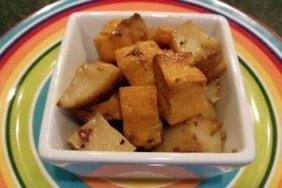Why are these foods called “Uncommon” or “Exotic”?
Are you wondering about offering your baby Onions, Mushrooms, Peppers, Celery and maybe Lychees? Maybe you’d like to introduce Coconut to your baby or maybe some Star Fruit mixed into Yogurt? Many parents ask about certain foods that are not found on a typical “Solid Food Chart“.
Foods like onions, peppers, figs etc. are neglected on baby food charts as these foods are seldom eaten alone and are usually considered additions to meals. Also, in the U.S. it is commonplace for advising only bland (and boring) baby foods. This website is based in the United States and as such, many foods that are not commonly consumed in the United States might be left off of the solid food chart. I know that the cultural variations in weaning and solid foods are vast and I hope this page may help you as you look to include other foods in baby’s expanding diet.
Spices:
Information on offering your baby spices may be found here with our Spice It Up page. You’ll be surprised at how easy it is to spice up your baby’s meals and stimulate and excite his taste buds.
Tofu:
Looking for information on how to introduce and incorporate Soy/Tofu in your baby’s diet, What to do with Tofu has all the information you need; from preparation, storage and even recipes.
“UN”common Fruits for Baby Food
Coconut
Coconut allergy is very rare. The coconut is not in the tree nut family, it’s actually a member of the palm family. Many in the U.S. may not think that coconut is a good food to offer a baby. I think this might be because we think of the large round shelled coconut and the more hard/dry meat that is inside it; there really is no way to prepare coconut “baby food” and offering a baby a dish of pureed coconut is really not an option.
There is more to the coconut than meets the casual eye however. Seldom do we in the U.S. (and even in North America) realize that many cultures use coconut milk for example, almost every day in their meals. Coconut milk is very healthy and many cultures begin to offer infants coconut milk early on, around 6-8 months old. Most children in the U.S. will encounter coconut first in baked goods and it is rare that coconut milk is regularly consumed or offered in the U.S although a growing trend of drinking coconut water is taking hold!
Coconut milk may be incorporated into a variety of rice and meat dishes if your pediatrician indicates this is fine for your baby. Learn about the “water coconut” and the jelly like meat it contains along with more information at Coconut Facts from Kate’s Global Kitchen
Did You Know? Coconut oil is a great replacement for vegetable oils when cooking; unlike other oils such as Flax Oil, coconut oil will withstand high temperatures and not turn rancid. There is one caveat in that most coconut oil is processed, bleached and washed through with chemicals. If you decide to use this healthy oil, ensure that you purchase only virgin coconut oil. Coconut oil does contain a high amount of saturated fats however the type of saturated fat is not the “bad” kind. Coconut oil will also solidify so don’t be alarmed when you find the coconut oil in your cupboard has turned solid.
Pomegranates, Passion Fruit, Figs and Dates, Lychees, Persimmons, and Star Fruit – Oh My.:
Here are a few “uncommon fruits. These are all very low on the allergy list and any rare occurrence of a reaction has been traced to a cross-reactivity, typically with birch pollen.
Visit the Pomegranates page to learn about pomegranates and how they might be incorporated into baby’s diet.
Lychees
Lychees are very sweet, high in vitamin C and yummy too. While it is very rare, there have been a few incidences of dermatological reaction to lychees due to cross-reactivity.
Lychees, Persimmons and Star Fruit may be peeled and offered when fully ripe to your baby around 8-10 months old. You may give them a gentle steaming if you wish, prior to serving them. With Persimmons, it is most common to find them being eaten puréed within baked goods.
Passion Fruit
Passion fruit may be a bit acidic so consider offering it later on to your older infant; it is very yummy when fully ripened and serves in small dices.
Figs and Dates
Figs and dates are highly nutritious and not allergenic. The only issue with Figs and Dates is in their preparation and texture. You could mix very small bits of dates and scrapings of Fig into your older baby’s cereals, yogurt, fruits and even meats. We don’t think that puree of Date or purée of Fig would make for a nice “meal”. Dates and Figs make for very yummy, naturally sweet snacks that older toddlers and children will love alone or in a nice trail mix.
Berries
Gooseberries and Chokecherries for example. Chokecherries may be very yummy however they may also be highly poisonous. It is the seeds that are poisonous and not the flesh itself. Be aware that there have been incidences of children who have been poisoned from eating chokecherries. As with other “true” berries as we call them (such as strawberry, raspberry, blackberry), you should offer berries when baby has reached 10-12 months old, depending on the history of family allergies. Blueberries and cranberries are the exception as they are not “true berries” in the sense they are not related to other berries and are not high on the allergen list. Read about Blueberries, Strawberries and Cranberries.
“UN”Common Vegetables for Baby Food:
Onions, Peppers, Mushrooms, Leeks and More
Parents most often ask about adding Onions, Mushrooms, Celery, Leeks and Peppers to baby’s diet.
These veggies may be sautéed and added to your child’s food between 8-10 months old. We do not recommend offering your baby an onion, mushroom, celery or a pepper puree rather we recommend that you add these wonderful veggies to food dishes. Should you decide to offer your baby onions, mushrooms, celery and peppers, please ensure that they are fully cooked, soft, and appropriately sized so as not to pose any choking hazard.
It is most important to cook mushrooms for your baby’s food. Mushrooms as we all know are fungi and cooking helps ensure their safety.
These veggies do not pose a high allergy risk however there may be certain digestive issues in a sensitive or delicate tummy. These veggies are probably best served in soups, casseroles, noodle/rice dishes. Our babies loved sautéed mushrooms with sauteed spinach. This would be for the older baby (10 months +) due mostly to the spinach.
Leeks
Leeks add a nice savory taste to any soup or main meal. As with onions and peppers, they are low on the allergy list and make for great seasonings and additions rather than served as a “meal” type food.
Fennel
Fennel is a great addition around 8 months old and may be added to soups, rice dishes or roasted with another vegetable like carrots. Check out the Roasted Fennel and Carrots recipe on the Blog!
Okra
Okra is one of those veggies that people either adore or despise. Most of us here happen to adore Okra (especially when deep fried – NOT healthy for young children however). Okra is rather difficult to work with and is limited in the ways to be prepare.
Okra purée is probably not an option and offering very very small pieces of Okra from a soup may be more appropriate. If you know Okra, then you are aware that the skin tends to be tough and the seeds are not very tiny. This may pose a choking hazard so if you plan on offering your infant (best around 10 months+) Okra, ensure that you offer only small bites that your baby can easily manage. Learn more about Okra on Wikipedia.
Wild Game –
Please visit our Wild Game for Feeding Baby page
While this information is provided based on research, I always urge you to consult your pediatrician. There are many instances when generalities may not or will not apply to individual babies.
DID YOU KNOW?
Sauteed onions, mushrooms and peppers add variety and extra yum to baby food from 8 months on!
![]() Remember, always consult with your pediatrician regarding introducing solid foods to your baby and specifically discuss any foods that may pose allergy risks for your baby.
Remember, always consult with your pediatrician regarding introducing solid foods to your baby and specifically discuss any foods that may pose allergy risks for your baby.
![]() This site complies with the HONcode standard for trustworthy health information:
This site complies with the HONcode standard for trustworthy health information:
verify here.


